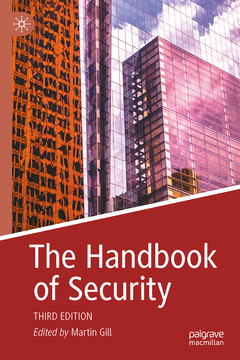1. Introduction, Martin Gill.- PART 1. The Subject Area of Security.- 2. Security: History, Genealogy, Ideology, Dodsworth, F.- 3. Shifting The Boundaries Of Security: Meanings And Applications, Dr Helen Forbes-Mewett.- 4. Explaining The Impact And Implications Of Covid-19 On Crime Rates: A Criminological Perspective , Rob Mawby.- 5. Forensic Intelligence And Traceology In Digitalised Environments: The Detection And Analysis Of Crime Patterns To Inform Practice, Olivier Ribaux Simon Baechler, Quentin Rossy.- 6. Changing Threats And Challenges In International Relations: Debating (In)Securities And Ways To Manage Them, Tochukwu Omenma And Silvia D’amato.- 7.- PART 2. Offence Types. - Private Security/Private Military: One Phenomenon Or Two?, Adam White.- 8. The Evolution Of The Terrorism And Extremism Landscape In The Age Of Covid-19, Kumar Ramakrishna.- 9. Violence Against Shop Workers: Trends And Triggers In The United Kingdom, Emmeline Taylor.- 10. Burglary Research And Conceptualizing The Community Security Function, A Learning Organization, Jim Calder April.- 11. Meeting The Challenges Of Fraud In A Digital World, Cassandra Cross.- 12. Examining Private Sector Strategies For Preventing Insurance Fraud, Dr. Yuriy Timofeyev And Mike Skidmore.- 13. Economic And Industrial Espionage: Characteristics, Techniques And Response, Mark Button And Susanne Knickmeier.- 14. Combatting Money Laundering: Some Considerations For Security Professionals, Professor Mike Levi.- 15. - PART 3. Crime And Security In Different Domains. - Corruption, Bribery And Corporate Crime: Victims And Perpetrators, Hock, B., Shepherd, D And Button, M.- 16. Securing The Bioeconomy: Exploring The Role Of Cyberbiosecurity, Patrick Walsh.- 17. Border Security: An Essential But Effective Tool In Combating Cross-Border Crime, Prof Anthony Minnaar.- 18. Security In The Chemical Industry: Theory And Practice, Chao Chen And Genserik Reniers.- 19. The Evolution Of College And University Campus Security In The United States: Congressional Legislation, Administrative Directives, And Policing, Bonnie Fisher, Michelle Protas, Logan Lanson And John Sloan.- 20. Addressing The Security Issues Related To Illegal Commercial Fishing, Gohar A. Petrossian And Ron Clarke.- 21. Crime On The Darknet: The Case Of Brand Abuse, Victoria Wang. Jim Gee, Mark Button.- 22. - PART 4. Researching Security. - Representing Security: A Popular Criminology Of Private Policing In Film, Steven Kohm.- 23. Systematic Reviews And Meta-Analysis Of Security, Matthew Manning, Gabriel T.W. Wong, Hien-Thuc Pham.- 24. Realistic Evaluation And The 5is: A Systematic Approach For Evaluating Security Interventions, Andrew Newton.- 25. Script Analysis For Security Professionals: Past, Present And Future, Dr. Harald Haelterman.- 26. Using Mobile Applications And Physiological Sensing To Measure Perception Of Security In Built Environments, Reka Solymosi, Ines Guedes, Laura Vozmediano.- 27.Researching The Relationship Between Tourism And Crime: The Tourism Industry And The Disenfranchised Citizens, Rob I Mawby And Zarina I Vakhitova.- PART 5. Security Products And Services. - 28. Security Officers: The Public Face Of The Security Industry, Mahesh K. Nalla And Alison Wakefield.- 30. Private And Corporate Investigations – Internal Security Governance Within Organisation, Clarissa Meerts.- 31. Training And Education Within The Security Sector: Challenges And Opportunities For Development, Declan Garrett, Glen Kitteringham And Ken Livingstone.- 32. CCTV As A Socio-Technology, Markus Lahtinen And Benjamin Weaver.- 33. Intrusion Detection Systems In The Protection Of Assets, David J Brooks.- PART 6. Towards a Better Security. - 34. Crime And The Consumer Internet Of Things, Shane D Johnson, John M Blythe, Eon Kim And Nissy Sombatruang.- 35. Professional Security In The Fourth Industrial Revolution, Alison Wakefield And Mike Gips.- 36. Security Or Liberty? Human Rights And Protest, Kate Moss.- 37. Facilitating Best Practice In Security: The Role Of Regulation, Tim Prenzler And R Sarre.- 38. Formal And Informal (In)Security In South Africa, G. D. Breetzke.- 39. Facing Up To The Future: The Role Of Horizon-Scanning In Helping Security Keep Up With The Changes To Come, Paul Ekblom.- 40. The Securitization Of Terrestrial Protected Areas, William D. Moreto.- PART 7. The Impacts of Security. - 41. The Carbon Footprint Of Crime And Security,Helen Shoesmith (Nee Skudder), Ian Brunton-Smith, Andromachi Tseloni, Rebecca Thompson, And Angela Druckman.- 42. Security And International Crime Drops, Nick Tilley And Graham Farrell.- 43. The Role Of Crime Prevention Through Environmental Design (Cpted) In Improving Household Security Rachel Armitage, Lisa Tompson.-44. Examining The Use Of Video Technologies In Retailing, Adrian Beck.- 45. Making An Economic Case For Security, Matthew Manning, Christopher M. Fleming, Hien-Thuc Pham.- 46. Business Resilience To Crime: The Harms Of Crime, Business Fragility And The Role Of Security, Matt Hopkins.- 47. Security In Perspective, Martin Gill.




